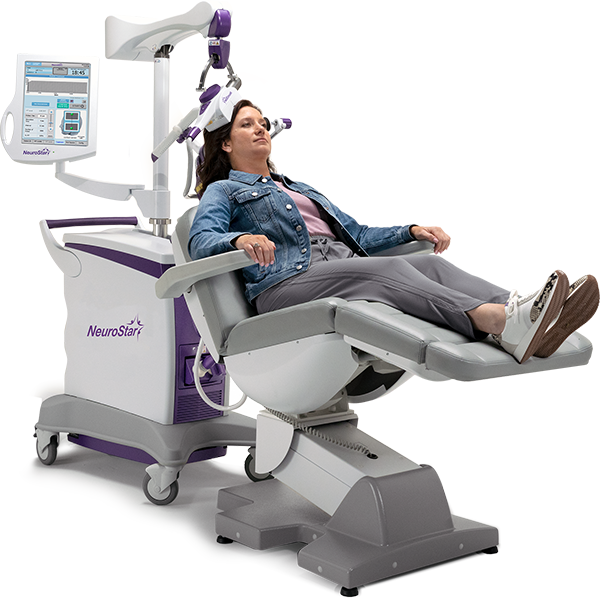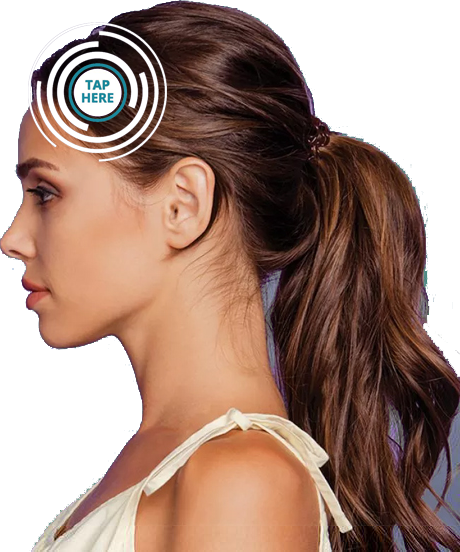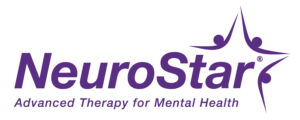NeuroStar uses transcranial magnetic stimulation (TMS) to target key areas of the brain that are underactive in people with depression. It is different from ECT (electroconvulsive therapy). Although the exact cause of depression is unknown, patients with depression tend to have an imbalance of activity levels in certain parts of the brain. NeuroStar TMS helps depression by helping to restore this balance.

What is NeuroStar Advanced Therapy (TMS)?
During a NeuroStar treatment session, a magnet similar to an MRI machine is used to stimulate nerve cells in an area of the brain that is involved in controlling mood. These magnetic pulses may have a positive effect on the brain’s neurotransmitter levels. This makes long-term remission possible.
Treatment with NeuroStar Advanced Therapy generally consists of the following:
• Therapy sessions conducted in your NeuroStar psychiatrist’s office
• A quick return to your normal routine
• Treatments conducted while you are awake
• NeuroStar Advanced Therapy does not usually cause problems with memory or sleep and has no sexual side effects
• Coverage from most insurance plans, including Medicare and TRICARE.
This innovative treatment has been tested and proven effective over 5 million treatment sessions. TMS treatment is bringing new hope to people suffering from depression and mental illness every day.
What to Expect
Here’s what you can expect from a NeuroStar Advanced Therapy (TMS) session:
TMS Testimonials
Check out these client testimonials from real people whose lives have been changed by NeuroStar TMS treatment:
Contact Us
Frequently Asked Questions
Transcranial magnetic stimulation, often referred to as TMS, is a noninvasive procedure that uses magnetic fields to stimulate nerve cells in the brain to improve symptoms of depression. TMS is typically used when antidepressant medications haven’t been effective, have ceased working, or as an alternative to medication.
TMS involves delivering magnetic pulses to specific parts of the brain.
A typical initial course of treatment is about 5 to 20 minutes daily, 5 days per week for 4-6 weeks.
A vast majority of commercial and Medicare plans have recognized the effectiveness of treating depression with TMS Therapy and now cover TMS as part of their plans.
TMS does not circulate in the blood throughout the body, so it does not have side effects like weight gain, sexual dysfunction, nausea, dry mouth, sedation, etc. The most common side effects reported during clinical trials were headache and scalp discomfort —generally mild to moderate—occurring less frequently after the first week of treatment.
No. TMS Therapy involves a unique method of using pulsed magnetic fields for a therapeutic benefit. The intensity of the magnetic field is similar to that of an MRI. These techniques differ radically from the popular use of low intensity, static magnetic fields. Those products deliver weak and undirected static fields that are not capable of activating brain cells. The activation and stimulation of brain cells is a key part of why TMS is so effective.
TMS Clinical Trials & Academic Studies
1. Janicak PG, et al. (2015). Transcranial Magnetic Stimulation for The Treatment Of Major Depression. Neuropsychiatry Dis Treat 2015;11:1549–1560. https://www.ncbi.nlm.nih.gov/pmc/articles/PMC4492646/
2. O’Reardon JP, et al. (2007). (ɝFDF\ DQG SDIHW\ RI 7UDQVFUDQLDO 0DJQHWLF SWLPXODWLRQ LQ the Acute Treatment of Major Depression: A Multisite Randomized Controlled Trial. Biol Psychiatry, 62(11):1208-1216. www.ncbi.nlm.nih.gov/pubmed/17573044
3. George MS, et al. (2010). Daily Left Prefrontal Transcranial Magnetic Stimulation Therapy for Major Depressive Disorder: A Sham-Controlled Randomized Trial. Arch Gen Psychiatry, 67(5):507-516. www.ncbi.nlm.nih.gov/pubmed/20439832
NeuroStar Advanced Therapy System
The NeuroStar Advanced Therapy System is indicated for the treatment of depressive episodes and for decreasing anxiety symptoms for those who may exhibit comorbid anxiety symptoms in adult patients suffering from Major Depressive Disorder (MDD) and who failed to achieve satisfactory improvement from previous antidepressant medication treatment in the current episode.
The NeuroStar Advanced Therapy system is intended to be used as an adjunct for the treatment of adult patients suffering from Obsessive-Compulsive Disorder (OCD).
The most common side effect is pain or discomfort at or near the treatment site. These events are transient; they occur during the TMS treatment course and do not occur for most patients after the first week of treatment. There is a rare risk of seizure associated with the use of TMS therapy (<0.1% per patient).
NeuroStar Advanced Therapy is only available by prescription.
Visit neurostar.com for full safety and prescribing information.



